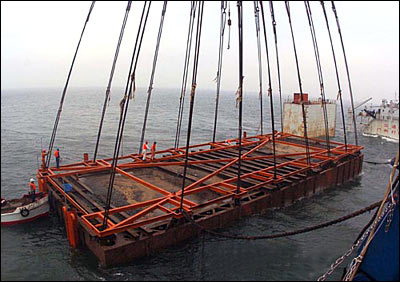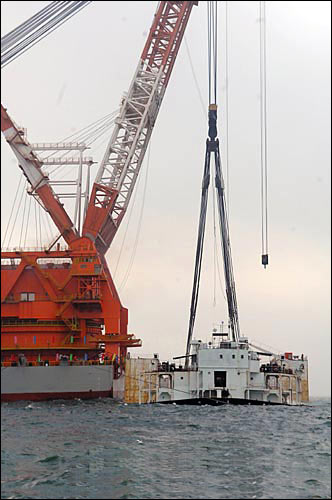A merchant boat loaded with porcelain that sank off the south China coast 800 years ago was raised on Friday, one day earlier than planned.
The salvage operation kicked off at 9 a.m. when a huge crane began lifting a steel basket containing the 30-meter-long vessel, dubbed the Nanhai No. 1, or "South China Sea No. 1".
Two hours later the wooden wreck breached the surface from 30-meter depth of water and was placed onto a waiting barge.
Archaeologists launched an operation in May to build a steel basket as large as a basketball field and as tall as a three-storey building around the boat to raise the wreck and the surrounding silt.
The basket, which has turned from orange to brown during seven months in water, together with its content weighed more than 3,000 tons.
"Soaked in the sea, the boat has become very fragile," explained Wu Jiancheng, head of the archaeological project.
Local officials originally planned to hoist the boat on Saturday but changed their minds due to favourable weather conditions on Friday.
The boat will be placed in a glass pool at a specially built museum named the "crystal palace" where the water temperature, pressure and other environmental conditions are the same as where the ship has lain on the sea bed.
The pool is 64 meters long, 40 meters wide and 23 meters high. It contains seawater and is about 12 meters in depth.
"It will be sealed after the ship and the silt are put in," said Feng Shaowen, head of the cultural bureau of Yangjiang City, Guangdong Province.
Though the salvage part has been done, Feng said, the excavation work will not be carried out immediately and it may last a quite long time.
"We want to make it sure before carrying out any excavation," said Feng."We have little experience of excavating underwater relics to follow and it will be a new challenge for us to protect the culture relics, such as wooden ware, which have stayed in the sea for a long time."
Guangdong has earmarked 150 million yuan (20.3 million U.S. dollars) to build a "Marine Silk Road Museum" to preserve the salvaged ancient ship.
The new museum, run by the municipal government of Yang Jiang, is expected to open to public by the end of next year and visitors will be able watch the on-going excavation of the ship through windows on two sides of the pool, said Feng.
Discovered in the summer of 1987 off the coast near Yangjiang city, Nanhai No.1 was recognized as one of the oldest and biggest merchant boat sunk in the sea.
Archaeologists have recovered more than 4,000 containers made of gold, silver and porcelain, as well as about 6,000 copper coins of the Song Dynasty (960-1279), when the boat was built.
Wu estimated that there were still 60,000 to 80,000 items on board.
Recovery of the boat would be significant in the study of porcelain in ancient China, according to Wei Jun, vice director of the submarine archaeology research center of Guangdong Research Institute of Cultural Relics and Archaeology.
He noted that the Song Dynasty was the first peak of porcelain industry in Chinese history, when the products were exported to east, south and west Asia, as well as the east coast of Africa, and the use of porcelain was seen as a symbol of social status.
The boat, buried in two-meter-thick silt, has archaeological value as well, Wei said.
"It is a sample of how wooden cultural relics could be well preserved for a long period," he said.
According to Huang Zongwei, professor with the Guangdong-based Sun Yat-Sen University, the boat was a proof of the "Marine Silk Road".
As early as 2,000 years ago, ancient Chinese traders began taking china, silk and cloth textiles and other commodities to foreign countries along the trading route. It started from ports at today's Guangdong and Fujian provinces to countries in southeast Asia, Africa and Europe.
"The 'Marine Silk Road', like the ancient Silk Road that connected China with south, west and central Asia and Europe, is also a bridge connecting eastern and western cultures," Huang said, "but evidence for existence of the path was rare."
Judging from the position of the sunken boat, whose head was pointing southwest, experts deduced that it could be heading to west Asia or the Middle East.
(Xinhua News Agency December 22, 2007)



